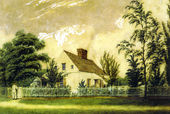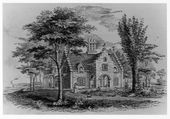Sunnyside
Sunnyside was the residence of the American writer Washington Irving from 1835 until his death in 1859. The stone house was formerly known as Van Tassel cottage, and was located on the Hudson River below Tarrytown. He made improvements and modifications to the architecture of the house as well as the surrounding landscaping and garden design. According to the National Register of Historic Places, Irving “delighted in augmenting the picturesqueness of his house by creating several wandering paths which led the visitor through secluded groves and broad vistas of the Hudson River scenery…perhaps influenced by [his] neighbor, Andrew Jackson Downing, who mentioned Sunnyside in his 1841 Treatise on the Theory and Practice of Landscape gardening in America.” In addition to these sylvan walks, Irving grew apples in his own orchard and cultivated flower and kitchen gardens laid out in geometric patterns which contrasted with the picturesque plan of the rest of the grounds.
Overview
Alternate Names: Van Tassel Cottage, Wolfert's Roost
Site Dates: The original Van Tassel cottage dates from the mid-to-late 1600's; Irving purchased the estate in 1835
Site Owner(s): Washington Irving (1783–1859)
Associated People: George Harvey (1800–1878; designer)
Location:Tarrytown, New York
View on Google Maps
History
Texts
- Downing, A. J., 1841, describing Sunnyside (1841: 334–336)[1]
- "There is scarcely a building or place more replete with interest in America, than the cottage of Washington Irving, near Tarrytown. The 'legend of sleepy Hollow,' so delightfully told in the Sketch-Book, has made every one acquainted with this neighbourhood, and especially with the site of the present building, there celebrated as the "Van Tassel House," one of the most secluded and delightful nooks on the banks of the Hudson. With characteristic taste, Mr. Irving has chosen this spot, the haunt of his early days, since rendered classic ground by his elegant pen, and made it his permanent residence. The house of 'Baltus Van Tassel,' has been altered and rebuilt in a quaint style, partaking somewhat of the English cottage mode, but retaining strongly marked symptoms of its Dutch origin. The quaint old weathercocks and finials, the crow-stepped gables, and the hall paved with Dutch tiles, are among the ancient and venerable ornaments of the houses of the original settlers of Manhattan, now almost extinct among us. There is also a quiet-keeping in the cottage and the grounds around it, that assists in making up the charm of the whole: the gently swelling slope reaching down to the water's edge, bordered by prettily wooded ravines through which a brook meanders pleasantly; and threaded by foot-paths ingeniously contrived so as sometimes to afford secluded walks, and at others to allow fine vistas of the broad expanse of river scenery."
- Downing, A. J., 1844, describing Sunnyside (1844: 38, 380)[2]
- "At Tarrytown, is the cottage residence of Washington Irvings, which is, in location and accessories, almost the beau ideal of a cottage-ornée. The charming manner in which the wild foot-paths, in the neighborhood of this cottage, are conducted among the picturesque dells and banks, is precisely what one would look for here. . . .
- "The cottage itself is now charmingly covered with ivy and climbing roses, and embosomed in thickets of shrubbery."
- Irving, Washington, February 5, 1846, in a letter to Mrs. Flora Foster Dawson (1864: 407–408)[3]
- "As to myself, on my return to America, I built me a pretty little cottage on the banks of the Hudson, in a beautiful country, and not far from my old haunts of Sleepy Hollow. Here I passed several years happily; my cottage well stocked with nieces, and enlivened by visits from friends and connections, having generally what is called in Scotland a houseful—that is to say, a circle more than it will hold. This state of things was too happy to last. I was unexpectedly called from it, by being appointed Minister to Madrid. It was a hard struggle for me to part from my cottage and my nieces, but I put all under charge of my brother, and promised to return at the end of three years. I have overstayed my time; nearly four years have elapsed. I understand my cottage is nearly buried among the trees I set out, and overrun with roses and honeysuckles and ivy from Melrose Abbey; and my nieces implore me to come back and save them from being buried alive in foliage. . . . When relieved from the duties and restraints of office, I shall make farewell visits to my friends in England and elsewhere; then ship myself for America, and hasten back to my cottage where everything is ready for my reception, and where I have but to walk in, hang up my hat, kiss my nieces, and take my seat in my elbow chair for the remainder of my life."
- Irving, Washington, May 20, 1851, in a letter to M. H. Grinnell (1864: 86–87)[4]
- "Sunnyside is possessed by seven devils, and I have to be continually on the watch to keep all from going to ruin. First, we have a legion of womenkind, cleaning and scouring the house from top to bottom; so that we are all reduced to eat and drink and have our being in my little library. In the midst of this, our water is cut off. An Irishman from your establishment undertook to shut up my spring, as he had yours, within brick walls; the spring showed proper spirit, and broke bounds, and all the water pipes ran dry in consequence. In the dearth of painters, I have employed a couple of country carpenters to paint my roofs, and it requires all my vigilance to keep them from painting them like Joseph's coat of divers colors. Your little man Westerfield is to plaster my chimneys to-morrow, and your plumbers and bellhangers to attack the vitals of the house. I have a new coachman, to be inducted into all the mysteries of the stable and coach house; so all that part of the establishment is in what is called a halla baloo. In a word, I never knew of such a tempest in a teapot as is just now going on in little Sunnyside. I trust, therefore, you will excuse me for staying at home to sink or swim with the concern."
- Irving, Washington, July 15, 1852, in a letter to Mrs. Storrow (1864: 107)[5]
- "I wish you could see little Sunnyside this season. I think it more beautiful than ever. The trees and shrubs and clambering vines are uncommonly luxuriant. We never had so many singing birds about the place, and the hummingbirds are about the windows continually, after the flowers of the honeysuckles and trumpet creepers which overhang them."
- Tuckerman, Henry T., 1853, describing Sunnyside (1853: 50–52)[6]
- "It is approached by a sequestered road, which enhances the effect of its natural beauty. A more tranquil and protected abode, nestled in the lap of nature, never captivated a poet's eye. Rising from the bank of the river, which a strip of woodland alone intercepts, it unites every rural charm to the most complete seclusion. From this interesting domain is visible the broad surface of the Tappan Zee; the grounds slope to the water's edge, and are bordered by wooded ravines; a clear brook ripples near, and several neat paths lead to shadowy walks or fine points of river scenery. The house itself is a graceful combination of the English cottage and the Dutch farm-house. The crow-stepped gables, the tiles in the hall, and the weathercocks, partake of the latter character; while the white walls gleaming through the trees, the smooth and verdant turf, and the mantling vines of ivy and clambering roses, suggest the former. Indeed, in this delightful homestead are tokens of all that is most characteristic of its owner. The simplicity and rustic grace of the abode indicate an unperverted taste,—its secluded position a love of retirement; the cottage ornaments remind us of his unrivalled pictures of English country-life; the weathercock that used to veer about on the Stadt-house of Amsterdam is a symbol of the fatherland; while the one that adorned the grand dwellings in Albany before the revolution, is a significant memorial of the old Dutch colonists; and they are thus both associated with the fragrant memory of that famous and unique historian Diedrich Knickerbocker. The quaint and beautiful are thus blended, and the effect of the whole is singularly harmonious. From the quietude of this retreat are obtainable the most extensive prospects; and while its sheltered position breathes the very air of domestic repose, the scenery it commands is eloquent of broad and generous sympathies. . . .
- "And here, in the midst of a landscape his pen has made attractive in both hemispheres and of friends whose love surpasses the highest meed of fame, he lives in daily view of scenes thrice endeared—by taste, association, and habit;&madsh;the old locust that blossoms on the green bank in spring, the brook that sparkles along the grass, the peaked turret and vine-covered wall of that modest yet traditional dwelling, the favorite valley watered by the romantic Pocantoro, and, above all, the glorious river of his heart."
Images
A. J. Downing, "Residence of Washington Irving, Esq. near Tarrytown, NY", in A Treatise on the Theory and Practice of Landscape Gardening (1849), p. 409, fig. 59.
Other Resources
Notes
- ↑ Andrew Jackson Downing, A Treatise on the Theory and Practice of Landscape Gardening, Adapted to North America, 1st edn (New York and London: Wiley and Putnam, 1841), view on Zotero.
- ↑ Andrew Jackson Downing, A Treatise on the Theory and Practice of Landscape Gardening, Adapted to North America, 2nd edn (New York and London: Wiley and Putnam, 1844), view on Zotero.
- ↑ Pierre M. Irving, The Life and Letters of Washington Irving, vol. 4 (New York: G. P. Putnam, 1864), view on Zotero.
- ↑ Irving 1864, view on Zotero.
- ↑ Irving 1864, view on Zotero.
- ↑ Henry T. Tuckerman, "Washington Irving," in Homes of American Authors; Comprising Anecdotical, Personal, and Descriptive Sketches, by Various Writers (New York: G. P. Putnam, 1853), view on Zotero.


